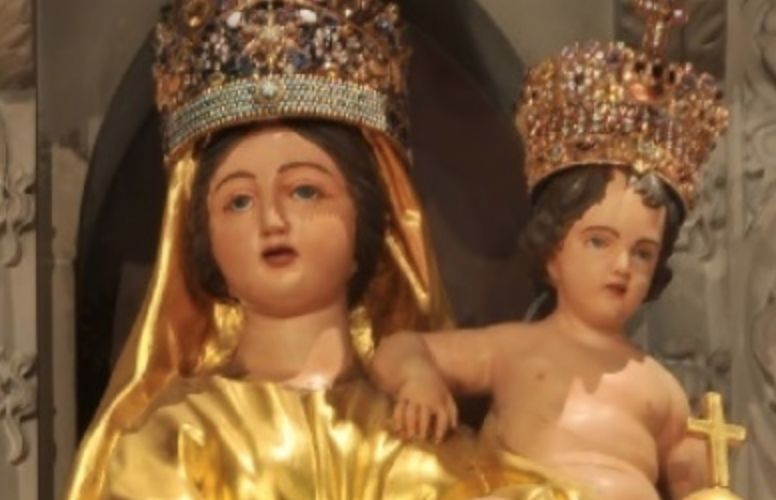
I thought I had seen just about everything, in terms of strange news-media takes on ancient-church teachings on prayer and the saints. Apparently not.
Just the other day, I wrote a post praising a news report on this topic, in part because of a short, clear, explanation of the term “venerate,” as opposed to “worship,” when dealing with a relic of a Catholic saint. See this: “Facing the heart of Jean Vianney: Reporters should be careful when covering saints and prayer.”
Now we have this “Oh, no!” headline at CNN.com: “As hurricane season starts, coastal Catholics call on this holy go-between for protection from devastating storms.”
Let’s start with the basics: Do Catholics believe there is some form of divinity, other than the Holy Trinity — God the Father, Son and Holy Spirit — who hears prayers and performs miracles?
In this headline the “holy go-between” is clearly St. Mary, the mother of Jesus. The term “go-between” is a bit brash, but does hint at the early church belief that is is proper to ask saints to join their prayers to God for a miracle or an answer to some other request. Are these believers claiming that the saint — St. Mary in this case — has the power to protect them or is that a God thing?
Truth be told, I have heard Catholics say things like “I prayed to St. Name Here and this or that happened.” In most cases, if you ask, “So you’re saying the saint performed this miracle?”, they will pause and acknowledge that it is God who hears prayers and responds, in one form or another.
So we need to see if this CNN.com report gets that right. But that isn’t the main reason a Catholic journalist sent me this CNN link. Check out this overture and see if you can spot the heresy in this news story:
(CNN) As Hurricane Matthew whipped up Florida’s Atlantic coast in 2016, Beth Williby got scared.
“That hurricane, in particular, just got my back up,” the Jacksonville mom of four recalled. “So, I did what any modern woman would do, and I Googled: Who do you pray to for protection from hurricanes?”
Her top result delivered the odd title of a special intermediary long known to Catholics across the Gulf Coast and beyond as the go-to gal for spiritual defense against wind-swept rain bands and storm surge floods.
Our Lady of Prompt Succor — a phrase that means “quick help” — is a version of the Virgin Mary known for delivering to her son, Jesus Christ, the prayers of those seeking “motherly care and consolation.”
Let’s pass over the “go-to gal” wording and focus on the word “version.” Here’s part of the email that I received from that Catholic media pro:
Yep, we’ve got all kinds of versions of the Virgin Mary — here’s the version for hurricane help, there’s the one for health, and that one over there is for getting husbands.
If you hit the Cambridge Dictionary online, you’ll find this definition of that rather ordinary word, “version.”
version (noun) … a particular form of something that varies from other forms of the same thing.
Whoa. So there is literally a “version” of St. Mary who is different from other “versions” of the same person? There’s more than one St. Mary?
Simply stated, the answer is: “No.”
Now, believers through the centuries, in various parts of the world, have given the mother of Jesus different names linked to locations of Marian appearances or, as in “Our Lady of Prompt Succor,” names describing characteristics of the woman who is, quite literally, the patron saint of the world.
But a different title or affectionate name does not mean that there are “versions” of St. Mary that are different from each other.
I think, in this case, a reporter and an editor simply went overboard trying to use causal language when writing about a complex subject that they just didn’t “get.” Check out the following, which is long, but essential:
With as many as four major hurricanes predicted this year, Our Lady’s spiritual inbox soon is sure to be teeming. And there’s little doubt a big swath of messages will arrive from Louisiana, a state over which she reigns as patroness and the principle setting of her backstory.
Lore holds that a French nun in 1803 hoped to join her cousin at the Ursuline Convent in New Orleans. But her local bishop, not wanting her to leave, insisted she get permission from the Pope, who was then a prisoner of Napoleon Bonaparte.
The nun wrote to the Pontiff and prayed this before a statue of Mary: “If you obtain for me a prompt and favorable answer to this letter, I make the promise to have you honored in New Orleans under the title of Our Lady of Prompt Succor.”
And so it was.
Our Lady of Prompt Succor also is credited for “the miraculous shifting of winds” that in 1788 and 1794 saved the Ursuline Convent in New Orleans from fire as well as with ensuring that a force of 3,000 Americans held off a British fleet three times its size during the 1815 Battle of New Orleans, the shrine’s official history states.
Now, in the middle of all of that, there is a crucial passage — in lofty language — that helps provide some focus. These words are addressed to Mary:
“If you obtain for me a prompt and favorable answer to this letter, I make the promise to have you honored in New Orleans under the title of Our Lady of Prompt Succor.”
Note the words “obtain” and “answer.” Who would this “answer” come from? That would be God. Also note that this statement says that St. Mary will be “honored” — not “worshipped” — under the TITLE of Our Lady of Prompt Succor. Once again, the fact that a person has more than one title does not mean there are different “versions” of that person.
Later in the story, there is this variation:
Since then, statues of the “quick help” iteration of Mary and her son have included golden robes, said Mary Lee Harris, assistant to the archivist at the Ursuline Convent Archives and Museum.
Uh, “iteration”? As in “a procedure in which repetition of a sequence of operations yields results successively closer to a desired result”? What does this word mean, here?
At the end of this long story there is a statement that is spot-on accurate. People who care about precise writing on this beat may wonder why this quote wasn’t used earlier. Catholic writer Beth Williby is quoted here:
“For me personally, it’s all about peace,” said Williby, who blogs at A Welcome Grace and Blessed Is She. “It’s about knowing that I have done the physical preparations I need to do, and I am asking for her to pray that we stay safe. But ultimately, our fate is not for us to decide.
“It’s not that I’m asking for the storm to part and go around our house,” she continued. “I’m asking to bring us peace and let us get through this however that’s going to be and that God grant us the strength to take on whatever is coming.”
Right there. That’s the big idea.
Note that this believer is asking St. Mary to “pray” that God will “grant.” As someone who has lived in hurricane land for large portions of my life, readers can assume that lots of believers are offering lots of prayers under those circumstances. Asking the mother of Jesus to join in those urgent prayers is a church tradition that is 2,000 years old.
That’s the equation that journalists need to understand.










